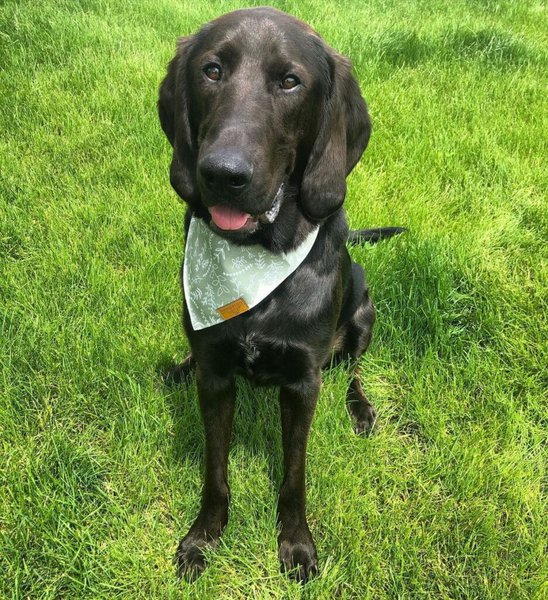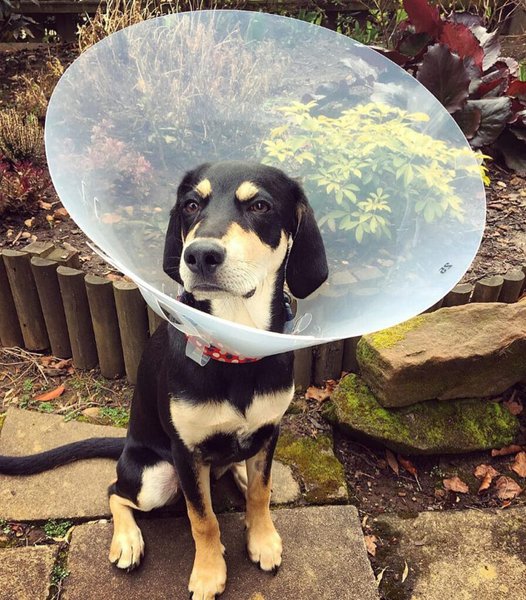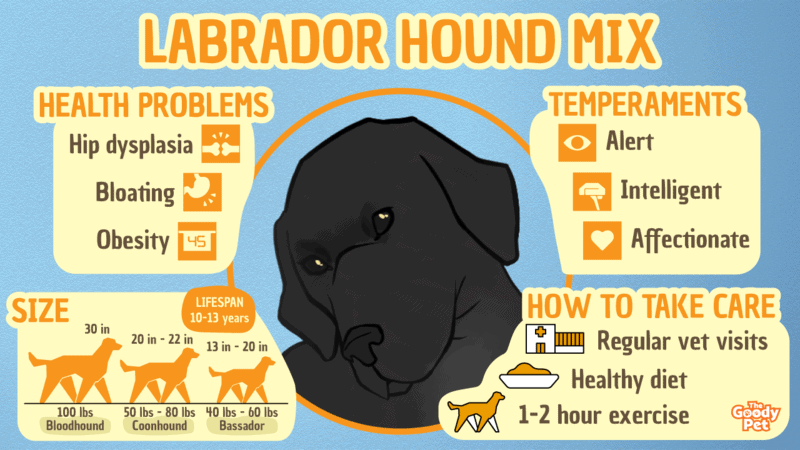Labradors are everything anyone can want in a dog. They are beautiful. They are super smart. And they are loyal almost to a fault. The only way to make Labs any better than they already are would be to mix them with another equally awesome breed. One of the few dog breeds or groups out there that comes close in terms of general impressiveness is the hound group. This is why the Labrador Hound Mix is such a popular pairing.
Labrador Hound Mixes are mixed breed dogs developed from breeding between a Labrador Retriever and any purebred dog from the Hound family of dogs. More often than not, dog breeders use the Basset Hound, the Bloodhound, and Coonhound, for the pairing for their aesthetics.
Let us take a closer look at exactly what it is about Labrador Hound Mixes that make them special, as well as what to expect if you end up owning one.
How Big Will A Lab Hound Mix Get?

Labrador Hound Mixes are difficult to describe and predict when it comes to things like their size and physical features. There are way too many variables, especially the fact that the mix can be with a number of unique hound breeds that come in different sizes, shapes, and colors.
However, looking at the most common pairings involving hounds like the Basset Hound, Bloodhound, and Coonhound, there are a few features that you may expect. Here is an overview of what you have to look forward to.
Size
Labrador Hound Mixes vary from medium-sized dogs to large pooches depending on the hound they are mixed with.
When Basset Hounds are used for the mix, the resulting Bassador is likely going to be smaller than a purebred Labrador Retriever and will usually range between 40 to 60 lbs in weight and 13 to 20 inches in height.
If the mix is with a Coonhound, on the other hand, the Lab Hound Mix will fall in a 50 to 80 lbs and 20 to 22-inch size bracket.
The largest Labrador Hounds result from mixing with the Bloodhound. These mixed doggies can grow up to 100 lbs and 30 inches.
Build
Both Labradors and members of the Hound group are very athletically built. The Lab Hound Mix takes after this with a muscular form that may be compact and proportional like the Labrador and the basset’s or a bit longer and narrower as is the case with sighthounds like the greyhound.
Facial And Skull Features
These are the most unpredictable of them all, as Labradors are drastically different in appearance from all hound variations. The best way to summarize this is that the final result in the Labrador Hound Mix’s appearance depends entirely on genetics and chance.
How Long Do Lab Hounds Live?

Labrador Retriever Hound Mixes can live for 10 to 13 years. The same can be expected from purebred Labrador Retrievers as well as most Hounds.
In general, Labrador Hounds are healthy dogs with few disease predispositions and even a few potentially life-threatening conditions. Here are some of the common health problems you may encounter if you have a Labrador Hound Mix.
Hip Dysplasia
Hip dysplasia in Labrador Hound Mixed Doggies is more commonly found in instances where large hound dogs have been used, and as a result, large mixes are produced. The condition involves an abnormal formation of the hip joint, which results in instability of the entire joint unit.
In severe cases, the condition could greatly impact the dog’s activity levels and may even eventually result in arthritis.
Osteochondrosis Dissecans (OCD)
Another musculoskeletal condition you may have to look out for with Labrador Hound Mixes is osteochondritis dissecans. To put it simply, this is where the blood supply to the bone at the joint level is inadequate, resulting in localized death of bone cells.
The cartilage over the affected bone eventually detaches, resulting in a world of pain and mobility problems for the pooch.
Bloat
Bloat is very common in Labradors and Basset Hounds and is a result of twisting of the stomach when dilated and subsequent obstruction of the outlet. The condition may be passed on to the mix and is particularly common in Bassadors.
Obesity
Obesity is a common issue both in Labradors and most Hound dogs despite both groups of dogs being bred primarily for use as active hunting dogs. When kept mainly as companion pets, overeating combined with limited mobility may result in unhealthy weight gain.
How To Take Care Of Labrador Hound Mixes?
Labrador Retriever Hound Mixes are generally low maintenance dogs.
However, the fact that they are easy to take care of is not reason enough to slack off, as improper care practices can affect both the quality and length of their lives.
To help you take the best possible care of your Lab Hound Mixed pooch, here are 3 of the most important care tips you need to know and practice.
Watch What And How Much You Feed The Lab Hound Mix
A lot of health issues that Labrador Hound Mixes face can be solved or, at the very least, made more manageable by a healthy diet.
Being healthy, in this case, means that a diet has to have the appropriate balance of nutrition, is sourced from high-quality ingredients, and is in appropriate portions by taking into account the dog’s age and activity levels.
Pet Plate is ideal in this case as it takes care of all these variables for you. Their meals are made from human-grade ingredients, with proportions and portions being customized to your dog’s specific needs.
Set Aside 1 To 2 Hours A Day For Exercise
It is very important that you keep your Lab Hound Mix active both for their physical and psychological health. Depending on your dog’s personality and energy levels, you can have play time from 30 minutes a day to two hours a day.
We recommend you get yourself the iFetch Interactive Ball Launchers For Dogs to make even the shortest of sessions fun and engaging for the pooch. The best part is that you get to choose the distance at which the balls are thrown depending on the amount of space available to you.
Schedule Regular Vet Visits
It is advisable to schedule at least 2 visits to the vet every year for Lab Hounds.
If the dog has fallen sick, you may have to increase the intervals as per your vet’s advice. These allow for early detection of any possible health issue for prompt management, which is usually more successful.
Are Lab Hound Mix Good Dogs? Temperaments Of Labrador Hound Mixes
Labradors are hailed as the most popular dog breeds, with their charming temperament being one of the main reasons for their popularity.
On the other hand, Hounds are usually a bit more standoffish, goal-focused, and independent. So how do these two personalities work together in the Lab Hound Mix? Here are a few common traits you may notice in your mixed pooch.
Alert
Labrador Hound Mixes make for really amazing hunting dogs and watchdogs due to their alert nature. They are very sensitive to everything from movement to unfamiliar scents and will not hesitate to raise the alarm if trained to do so.
Intelligent
Most hounds are not known to be very intelligent or responsive. However, there is something about this pairing with the smart Labrador Retriever that makes the resulting mix very intelligent and generally easy to train.
Energetic
The Labrador Hound Mix is a very active dog and is happiest outdoors, where it can run and work out all its energy. If not allowed to play on a regular basis, Labrador Hounds are likely to get frustrated and develop destructive behavior.
Loyal
One of the best personality traits you have to look forward to from Labrador Hound Mixes is their unwavering loyalty. These dogs love their human companions and are very protective, especially over children.
Affectionate
Labrador Hound Mixes may not be the most sociable mixed doggies, but they make up for this with their affectionate nature toward the people that they trust the most.
If you want to sharpen your social skills and share this affectionate side with strangers your dog meets, all you have to do is start socialization training from an early age for Lab Hound Mixes.
Do Hound Lab Mixes Shed? Grooming Tips For Labrador Hound Mixes
Another very unpredictable feature with Labrador Hound Mixes is the coat type and subsequently the grooming needs.
Labradors are known to be heavy shedders due to their short and dense coats. Hounds, on the other hand, generally do not shed very much, with some specific breeds, like the Afghan Hound being hypoallergenic.
Whatever type of coat your dog ends up having, here are a few grooming tips that will come in handy to keep their coats healthy and beautiful.
Settle On A Regular Deshedding And Detangling Schedule
If your Labrador Hound Mix sheds heavily, you may have to brush them 3 to 4 times a week to get rid of loose fur. More often than not, the dog will also have a thick coat, in which case we recommend you invest in the FURminator Undercoat Tool.
This grooming brush has strong, metallic bristles that are exactly what you need to get through the dense double coat. If your Labrador Hound Mix sheds less, brushing once or twice a week will be enough.
In both cases, we also recommend you look into the iRobot Roomba i3+. This is because even with a good grooming schedule and tools, some fur will make it to your surfaces. The automated vacuum is designed specifically for these kinds of pet messes and will make your life easier.
Wash The Labrador Hound Once Every 6 To 8 Weeks
Labrador Hound Mixes can get stinky, especially if they are very active and spend a lot of time outdoors. Washing them on a regular basis helps deal with the odor as well as keep their coat healthy and beautiful.
For all this, you need to use a good quality shampoo like the Seamus Cherry Blossom Whitening Dog Shampoo. Despite the name, this shampoo works wonders on both white fur and other colors, from black to brown and even red. It will condition your dog’s fur and intensify the natural colors for a truly beautiful pooch.
Related Questions
How Long Do Basset Hound Lab Mixes Live?
A Basset Hound Labrador Mix can live for 10 to 12 years if they are generally healthy and well taken care of. Also known as Bassadors, this mix is generally unproblematic when it comes to health issues. The few health problems that Basset Labrador mixes do have are also rarely life-threatening.
How Big Will A Lab Bloodhound Mix Get?
A Labrador Bloodhound Mix can grow to weigh 70 to 100 lbs and measure more than 30 inches in height. They are among the largest of the Labrador Hound group of mixed doggies. This is largely due to the heavyset nature of the Bloodhound compared to other hounds that the Labrador is mixed with, like the Basset Hound and Coonhound.
Do Hound Mix Dogs Shed?
Hound Mixed Dogs shed between minimal to heavy levels. The amount and frequency of the shedding depend on a number of factors, with the most important being the dog breed that the Hound is mixed with. If they are mixed with heavy shedders, there is always the possibility that the resulting dog sheds heavily. However, if the hounds are mixed with light to moderate shedders like themselves, then the grooming needs may be more manageable.





